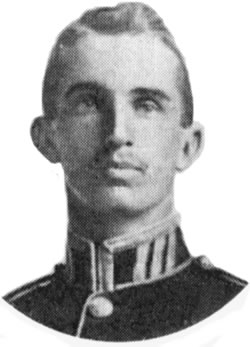In Flanders Fields
by John McCrae, May 1915
In Flanders fields the poppies blow
Between the crosses, row on row,
That mark our place; and in the sky
The larks, still bravely singing, fly
Scarce heard amid the guns below.
We are the Dead. Short days ago
We lived, felt dawn, saw sunset glow,
Loved and were loved, and now we lie
In Flanders fields.
Take up our quarrel with the foe:
To you from failing hands we throw
The torch; be yours to hold it high.
If ye break faith with us who die
We shall not sleep, though poppies grow
In Flanders fields.
Inspiration for “In Flanders Fields”

|
During the early days of the Second Battle of Ypres a young Canadian artillery officer, Lieutenant Alexis Helmer, was killed on 2 May, 1915 in the gun positions near Ypres. An exploding German artillery shell landed near him. He was serving in the same Canadian artillery unit as a friend of his, the Canadian military doctor and artillery commander Major John McCrae.
As the brigade doctor, John McCrae was asked to conduct the burial service for Alexis because the chaplain had been called away somewhere else on duty that evening. It is believed that later that evening, after the burial, John began the draft for his now famous poem “In Flanders Fields”.
For the story behind the inspiration for “In Flanders Fields”, see our page at:
Inspiration for In Flanders FieldsRelated Topics
The Story Behind the Remembrance Poppy
Also known as “The Poppy Lady” find out how this poem inspired the American teacher, Moina Belle Michael, to write a poem in response to “In Flanders Fields”. Discover how she and Frenchwoman Madame Anna Guérin, known as “The French Poppy Lady”, encouraged people to use the red Flanders poppy as a way of remembering those who had suffered in war, and how the Flanders Poppy became the symbol of remembrance that we know so well today:
The Story Behind the Remembrance Poppy
Essex Farm Advanced Dressing Station, Ypres
Find out more about the battlefield location where the poem is believed to have been composed on the evening of 2 May 1915.
Essex Farm Advanced Dressing Station, Ypres Salient
Related Reading

In Flanders Fields
by Linda Granfield
The story of John McCrae's World War I poem interweaves the poet's words with information about the war, details of daily life in the trenches, accounts of McCrae's experience in his field hospital, and the circumstances that contributed to the poem's creation.

A Crown of Life - The World of John McCrae
by Dianne Graves
The words of John McCrae, a soldier, doctor and poet, are called to mind every year on 11 November. It was his poem, In Flanders Fields, that was the inspiration for the poppy as a symbol of remembrance. This book charts the story of his life.
Acknowledgement
(1) Photograph of Lieutenant Alexis Helmer. Featured in A Crown of Life: The World of John McCrae, by Dianne Graves

